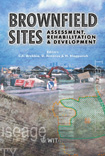In-situ Chemical Oxidation Of A Chlorinated Groundwater Plume At A Brownfields Site
Price
Free (open access)
Transaction
Volume
55
Pages
Published
2002
Size
493 kb
Paper DOI
10.2495/BF020461
Copyright
WIT Press
Author(s)
P. Kakarla, R. Greenberg & T. Andrews
Abstract
In-situ chemical oxidation of a chlorinated groundwater plume at a brownfields site P. Kakarla, R. Greenberg & T. Andrews In-Situ Oxidative Technologies, Inc., USA Abstract Groundwater at a former manufacturing facility to be converted to retail use located in Bergen County, New Jersey, USA was contaminated with chlorinated solvents principally consisting of Trichloroethene (TCE), Vinyl chloride (VC) and Cis-l, 2-Dichloroethene (Cis-DCE). A patented Fenton-based oxidation process known as the ISOTECSM process was utilized to perform remedial activities at the site. A proprietary blend of chelated iron catalyst and mobility control agents that function in the pH range 5-7 was applied along with stabilized hydrogen peroxide to promote in-situ generation of the potent hydroxyl radical and other free radical oxidants, which occur as intermediaries in Fenton’s reaction. Laboratory comparison experiments conducted in soil columns revealed significantly higher mobility and superior sorption characteristics for ISOTECSM catalysts when compared to a conventional Fenton’s catalyst such as acidified iron (11) solution. For the highest column length used in the experiments, greater than 95% of iron in acidified iron (11) catalyst was adsorbed to the soil as opposed to less than 14% adsorption using the ISOTECSM catalyst. Preliminary laboratory-scale research was conducted to test the process efficacy towards in-situ chlorinated solvent remediation. Based on successful experimental results that indicated greater than 99% reduction of TCE, VC and cis-DCE; a field-scale treatment program was initiated utilizing a plurality of injection wells installed in a grid fashion throughout the site. Results of treatment indicated over a 98% reduction in total chlorinated contamination detected in the site groundwater within five months, which increased to greater than 99% decrease after one year.
Keywords




